It says something about the complexity of California’s water crisis that there are so many actors in the state’s water wars, all clamoring for more. Nature, alone, is silent in this fight, relying on others to speak on behalf of the welfare of wildlife and waterways.
Across the state, biologists, farmers and hunters are lending nature a helping hand. It’s sometimes an extreme intervention: trucking young salmon when drought shrinks rivers.
But this year these lifelines aren’t enough. Migratory birds — protected by state and national laws and an international treaty — are suffering mightily during this drought, even more quickly than they did during the last major dry spell, which lasted five years and ended in early 2017.
California is the most critical link in the 4,000-mile-long Pacific Flyway, a route along the West Coast where millions of birds shuttle between their summer and winter homes. It’s an arduous journey, hopscotching from wetlands and waterways, allowing birds to rest and refuel, shoring up strength for their trip.
Wildlife experts say this year’s severe drought has uncoupled that connectivity. Normal routes — long imprinted in migrating birds’ navigation systems — have gone haywire.
The great dryness has eliminated many of the flyway’s rest stops in California — particularly in the far north Klamath region — forcing ducks, geese, eagles, herons and other traveling birds to stay aloft and keep looking. Biologists in Northern California and Oregon say they are tracking flocks deviating far off established flight paths, seeking water where there is little.
Experts say evidence is already emerging a year into this drought that their labored journey is weakening and stressing birds that struggle to find wetlands along their journey to rest and feed.
This year is the driest on record in the Lower Klamath Basin, a lush region of marshes and streams that straddles the Oregon-California border. The refuges there are “almost completely dry,” said U.S. Fish and Wildlife Service spokesperson Susan Sawyer.
As a result, nearly all of the ducks have vanished. A recent aerial survey of the vast refuge showed about 34,000 ducks this year compared to 1.5 million in 1948; nearby Tule Lake refuge had only about 30,000 ducks in the survey, down from 3.5 million.
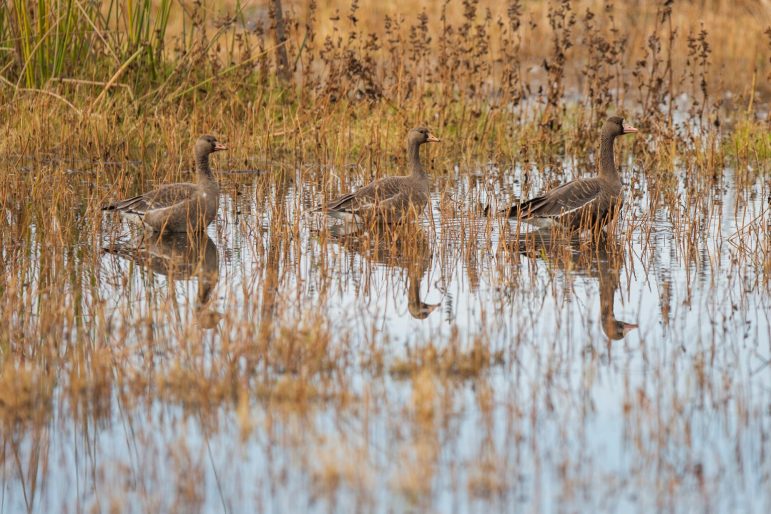
In the span of a few human generations, even in years of plentiful rain, 90% of California’s wetlands have disappeared to development and agriculture, so migrating birds are especially vulnerable to prolonged droughts.
“The journey, from the human perspective, is enormous,” said Andrew Farnsworth, who researches bird migration at the Cornell Lab of Ornithology. “It requires a lot of energy. Some start in Alaska. Flights of 4,000 miles are absolutely quite common, and they will fly nonstop for a few days. Having the resources they need is critically important.”
Melanie Weaver, waterfowl coordinator for the state Department of Fish and Wildlife, has confidence in the ability of migrating birds to adapt, saying “ducks and geese are wired to go through drought. They don’t fall out of the sky. They have wings, they move where food and water is.”
But the widespread nature of this drought throughout the West, and its severity and potential duration, may challenge even the most resilient wildlife.
“I’m concerned that we are not going to see the populations come back,” Weaver said. “This drought is bad. The odds are against us.”
Even recent winter storms — which dumped rain across the north and central parts of the state and swelled some rivers and streams — made no dent to ease California’s drought, wetlands loss or water shortage.
Resilient but still struggling
Resting and feeding spots at wildlife refuges are overcrowded this year, which can foster spikes in the infectious or water-borne illnesses spread by close quarters. Avian botulism and cholera, present even in wet years, spike in arid times. A botulism outbreak in the lower Klamath Basin last year killed an estimated 60,000 birds, likely many more.
So far the Klamath refuges have not experienced a severe disease outbreak like the one that took place last year. “But the spring could be a different story if birds leave the Central Valley early and return to the Klamath where there is little to no available habitat,” Sawyer said.
Klamath’s marshes, streams and grasslands provide vital stops during birds’ long journeys — more than 80% of migratory birds on the Pacific Flyway use them as a stopover in spring and fall. But the region has been one of the hardest hit in this year’s statewide drought.
Instances of young birds being “stranded” are amplified during drought. Dabbling ducks, which includes mallards and pintails, nest in upland areas and must walk to water sources. During dry periods those marches can be too long for young birds that have no flight feathers so they can’t survive. Biologists say this happens all over the state, even in normal years, but is more common during drought.
While the Klamath region is the hardest hit, wetlands farther south on the flyway are in bad shape, too. At the Sacramento River National Wildlife Refuge, the October bird count is not encouraging. By the third week in October last year, the rough waterfowl count was nearly 800,000 birds. This year, it was 600,000.
And, to illustrate how the intensity of this drought is coming sooner than the last: The refuge’s geese population today is less than half than it was for the same month in 2015, which was the region’s worst year during the last drought.
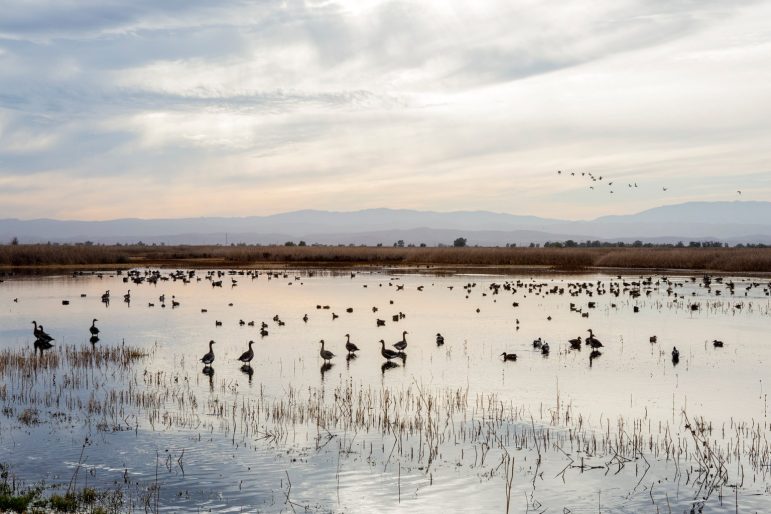
Biologists talk about the resilience of birds, hard-wired to just keep pushing on, but there is little good news now and even less for the near future. The National Audubon Society estimates that two-thirds of North American birds are at increasing risk of extinction because of climate change.
That vulnerability is repeated around the world: Only 9% of the planet’s migratory birds have protected areas along their routes, and loss of habitat and climate change is “a contributing factor to the decline of more than half of the migratory bird species across all major flyways in the last 30 years.”
Migrating birds, which a century ago filled the sky and blotted out the sun during trips along California’s long spine, need help.
To make the state more hospitable to migrating birds during the drought, state and federal programs are paying farmers to keep water on their fields. The state Department of Water Resources invested $8 million this fall. In the northern end of the Central Valley, agricultural land is flooded and managed as migratory bird habitat for exhausted annual travelers flapping in from as far away as Alaska and Russia.
But the amount of water from rivers and lakes allocated for wildlife refuges has been cut back substantially this year. The Lower Klamath Refuge has been operating with half its water allocations from rivers and streams since 2006, but this year has been devastating: It received less than 1% of its allocations.
With the loss of more than 99% of its wetlands, few chicks were born in the refuge this year. Most birds didn’t bother stopping there to nest, moving instead to refuges the Sacramento area, which received 75% of their usual water allocation.
“This past summer there was extremely reduced waterfowl reproduction on the (Klamath) refuge due to the very limited available habitat,” Sawyer said.
Diagnosis: drought
The juvenile golden eagle, tagged as No. 2-21-0824, lay splayed on his back on a stainless-steel necropsy table at the state Wildlife Health Laboratory north of Sacramento. He had been discovered dead in Bakersfield, on the ground and emaciated, and taken to a wildlife rescue organization. His carcass was placed in a black trash bag, frozen and sent by FedEx to Krysta Rogers, head of avian investigations for the state fish and wildlife agency.
Rogers’ job is to discover what caused the young bird’s death. She selected large pruning shears, the sort gardeners might use to lop off a large tree branch. With a loud crack, she snapped the bird’s femur, setting aside a section of bone for further analysis.
Methodically examining the carcass, Rogers knew that the bird was not among the uncounted animals to succumb to drought-related causes. Instead, the young bird’s death was a case of bad housekeeping. It’s likely that the eagle’s parents brought home meals of especially fatty squirrels, Rogers said. The fat coated the bird’s wings, rendering it unable to fly. In a final blow, it’s possible that his nest-mate pushed him out of the family home to keep the food to itself.
Ascribing a death to drought is a complex puzzle to solve, when nature offers so many ways to die. “It’s not often a direct, causative thing,” Rogers said, still hunched over the bird. “But we can say that in some cases it (drought) is a contributing factor” to bird deaths.

Krysta Rogers, a senior environmental scientist at the state’s Avian Investigations Wildlife Health Laboratory, gets ready to perform a necropsy on a band-tailed pigeon in Sacramento on Oct. 6, 2021. 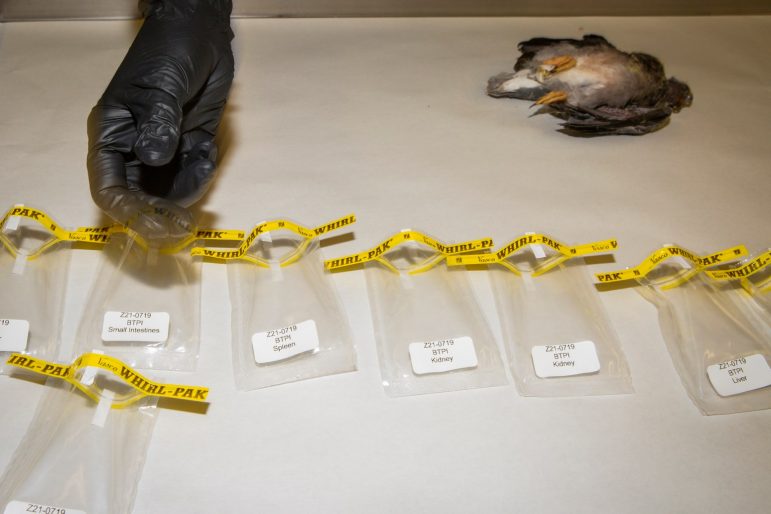
What drought does is render the already precarious existence for wildlife all the more dicey.
When normal weather patterns are off kilter, even in a small way, the impact on birds and their environment can be profound.
Birds can die during extreme heat events that sometimes accompany drought. That happened this spring and summer, with young barn owls dying of heat stress when sheltering in nesting boxes that people built in their yards in Contra Costa, Humboldt, Marin, San Diego, Stanislaus, Yolo and Los Angeles counties.
Water quality problems can occur when well-meaning people maintain backyard bird baths with stagnant, non-circulating water that speeds the spread of parasites. Disease can be spread when raptors or other animals prey on sick birds.
“Streams and creeks are not running like they typically would,” Rogers said. “Birds and other animals rely more heavily on artificial sources of water and food. I expect to see disease outbreaks at bird feeders and artificial sources of water such as bird baths and fountains.”
State wildlife officials can’t say with assurance that populations of migratory birds have declined; nearly two years of COVID-19 has grounded bird survey flights and this year’s winter migration has months to go.
But they have the last drought to go by, and that suggests migrating birds are in for trouble.
Scientists expect current data to mirror the declines during the height of the last drought. California’s population of breeding ducks in 2015 fell 30% compared to 2014, according to a U.S. Department of Fish and Wildlife survey.
“That didn’t surprise us,” said Weaver, of the state wildlife agency, who also sits on the Pacific Flyway Council. “Why breed when your habitat isn’t there? Local populations decline. They recover when conditions improve.”
Still, she said, the endless cycles of drought throughout the West, combined with drastic wetlands loss, could mean that migratory bird populations may not ever return to historic numbers.
Fields flooded for birds
In normal years, when water is plentiful and affordable, some 270,000 acres of winter rice fields in the Sacramento Valley are lightly flooded and available to receive wintering shorebirds, such as white faced ibis, great blue herons and many varieties of geese and ducks.
The Central Valley, with its usual bounty of food and space, supports 30% of the shorebirds and 60% of the ducks and geese in the entire Pacific Flyway, nearly 3 million ducks, 1 million geese and a half-million shorebirds overwintering annually.
Given the severe drought conditions and paucity of available water, there is substantially less habitat for those flocks this year. Luke Matthews, a biologist with the California Rice Commission, said his group estimates there are only 60,000 acres of flooded rice land this year. Adding the acreage supported by various state and private conservation programs brings the total agricultural winter habitat to just over 100,000 acres, Matthews said.
Still, from the perspective of hungry, exhausted migratory birds, the Sacramento Valley must appear from the air like a spa retreat featuring an all-you-can-eat buffet.
Once settled, the birds will derive 50% of their diet from rice left on the ground after the fall harvest. As much as 300 pounds of rice per acre is available to birds after the crop is harvested.
Agricultural lands have proved critical for filling in the gaps from California’s wetlands loss. Dense, clay soil is nearly impermeable – a shallow vessel of water ideal for growing rice and hosting birds. Since air pollution concerns almost ended the practice of burning off rice straw after harvest, flooding harvested fields benefit both farmer and bird: While feeding in the fields, tiny bird feet and stomping geese churn and aerate soils, helping rice straw decompose, preparing the land for the next season’s crop.
A disparate collection of agencies and private groups is funding “pop-up wetlands.”Farmers are increasingly raising their hands to host wetlands, seeing a dual benefit: For rice farmers, winter flooding makes financial sense but also appeals to those with a conservation mindset.
“We grow two crops: We grow rice and we grow birds,” said Nicole Montna Van Vleck, president of Montna Farms in Yuba City.
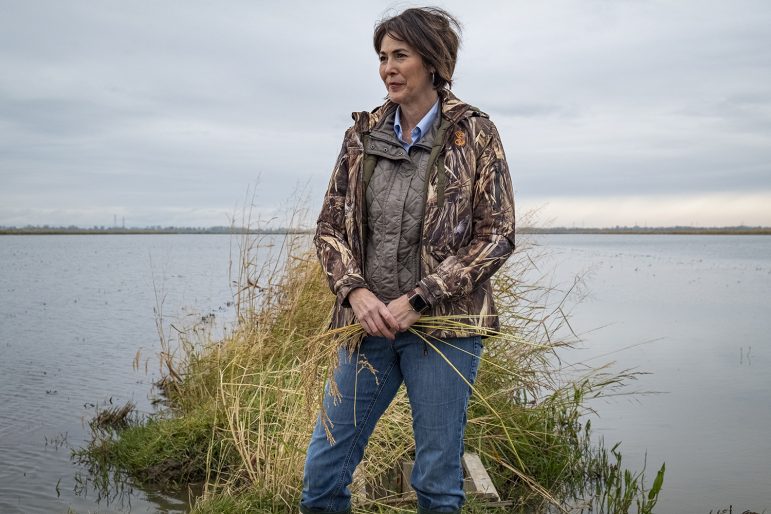
Flooded fields on Montna Van Vleck’s sprawling 5,000-acre farm look like shallow kiddie pools. Some paddocks are dark with thousands of resting birds, with white molting-season feathers collected around the edges like a bathtub ring.
“Every season for me is awe-inspiring,” she said, surveying the flat expanse of water and birds. “You can almost imagine what it was like when this was a natural floodplain, when you get out here and see these ricelands work. We’ve created this ecosystem for them. There’s plenty of food for them. I never get tired of it.”
One conservation program, called BirdReturns, was launched during the last drought and is operated in part by Audubon California, the Nature Conservancy and Point Blue Conservation Science. It creates a marketplace for private landowners to provide shallow flooding, mostly for shorebirds.
A similar program, called Bid4Birds, operated by the California Ricelands Waterbird Foundation, encourages rice farmers to participate in a marketplace where they are compensated for the cost of leaving water on their land for migratory birds.
The BirdReturns program has a goal of creating an additional 100,000 acres of habitat available every year, said Rodd Kelsey, The Nature Conservancy’s lead scientist on the project.
Despite the gains made since its inception in 2014, “this drought is much worse,” Kelsey said. Rice farmers “will tell you that the water situation is something they have not seen since the late 70s drought.”
Paul Buttner, California Ricelands Waterbird Foundation’s executive director, called the outlook “really, really dismal.”
The severity of the last drought drove once-bickering sides into collaborative problem-solving. The drought was a “stark and shocking wakeup call,” prompting bird groups, farmers, duck hunting clubs and state and federal wildlife managers to begin conversations, said Meghan Hertel, Audubon California’s director of land and water conservation.
More than half of the wetlands in the Sacramento Valley are privately owned, operated by duck clubs established for bird hunting. Land managers regularly called each other to track birds on the move, Hertel said. “They’d say, ‘Hey I’ve got 100,000 snow geese coming your way, hold on to your water.”
A place of refuge
Steering an SUV through the slanting afternoon light at the Sacramento River National Wildlife Refuge, Craig Isola keeps a pair of binoculars handy. As deputy manager, Isola is trying to get a fix on how this drought might play out there.
The birds, he said, are arriving at the refuge hungry as they couldn’t find wetlands or food during their journey south.
“We are seeing birds show up earlier here because of lack of water in the north, in the Klamath Basin,” he said. “Historically birds will stage and hold up in the Klamath Valley before flying down to Sacramento. But when there’s nothing to the north, they move south. The birds are coming in hungry.”
The Sacramento National Wildlife Refuge, operated by the U.S. Fish and Wildlife Service, is a string of five managed wetlands, seasonal pools and streams spread over 39,000 acres about an hour’s drive north of Sacramento. Established in 1937, the refuge provides critical wintering habitat for the Pacific Flyway’s birds.
Already, in October, tens of thousands of birds were scattered across the 10,000-acre Sacramento River Refuge, which is receiving water from Lake Shasta, via the U.S. Bureau of Reclamation, into the rain-starved marshes to accommodate the early arrivals. The refuge is operating on 75% of its usual water allocation, a generous amount compared to less than 1% at the Lower Klamath refuge and 16% at the Klamath region’s Tule Lake National Wildlife Refuge.
The refuge’s water grass and smartweed provide protein and fats to augment the carbohydrates birds get from the nearby rice farms. The flocks loaf in the refuge during the day and in the evening make their way to pick through the fields, where most of the rice is already harvested. It’s the time of day when the distant boom-boom of cannons echoes, fired off by growers to scare birds away from farms that have yet to harvest.
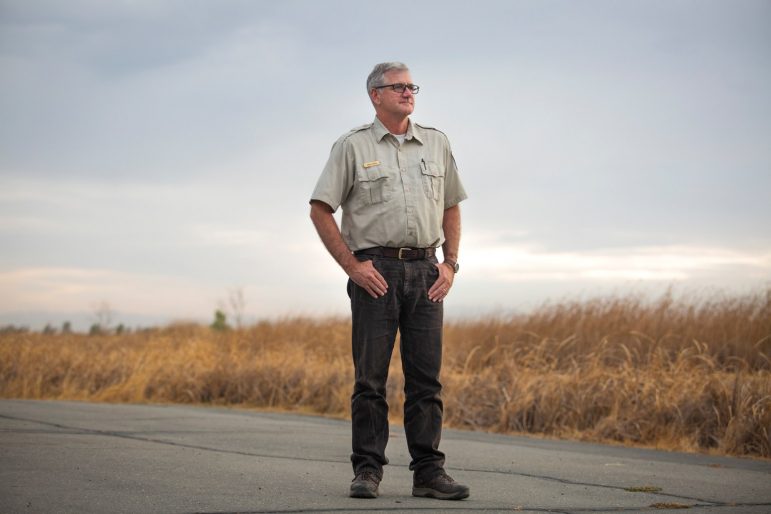
The newly arrived birds are jumpy, Isola said, not yet settled into their surroundings. Dusk is a restless time at the refuge, with a constant soundtrack of chittering and squeaking. Even a hint of a raptor gliding overhead causes an explosion of wings and water as flocks take to the air. Bald eagles and peregrine Falcons won’t attack migratory birds while they are flying.
Wildlife managers have an obligation to support migrating birds under the Migratory Bird Treaty Act, and in some cases state and federal endangered species laws. Beyond that legal charge, the animals’ health is a window into California’s environmental stewardship.
“Wildlife are the ultimate indicators on how this land is doing,” Isola said. “They represent the idea of maintaining biodiversity and the ability to evolve into the future, for all of us.”
